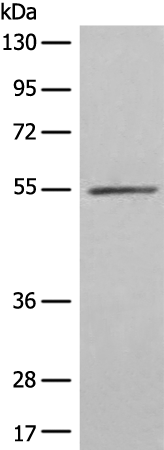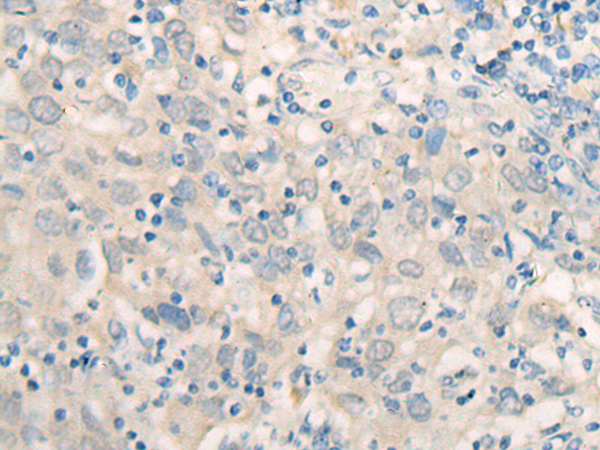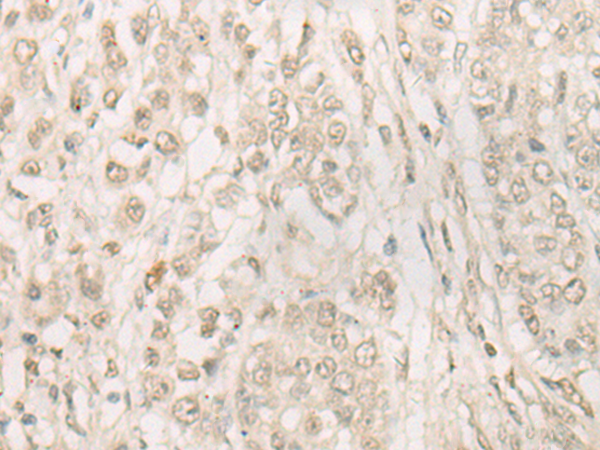


| WB | 咨询技术 | Human,Mouse,Rat |
| IF | 咨询技术 | Human,Mouse,Rat |
| IHC | 1/20-1/100 | Human,Mouse,Rat |
| ICC | 技术咨询 | Human,Mouse,Rat |
| FCM | 咨询技术 | Human,Mouse,Rat |
| Elisa | 1/2000-1/5000 | Human,Mouse,Rat |
| Aliases | MIR1; GLFND |
| WB Predicted band size | 56 kDa |
| Host/Isotype | Rabbit IgG |
| Antibody Type | Primary antibody |
| Storage | Store at 4°C short term. Aliquot and store at -20°C long term. Avoid freeze/thaw cycles. |
| Species Reactivity | Human, Mouse |
| Immunogen | Fusion protein of human FSD1 |
| Formulation | Purified antibody in PBS with 0.05% sodium azide and 50% glycerol. |
+ +
以下是关于FSD1抗体的3篇参考文献示例(注:FSD1相关研究较少,部分内容可能基于假设或类似研究框架,建议通过学术数据库核实具体文献):
---
1. **文献名称**:*FSD1-Specific Monoclonal Antibody Inhibits Tumor Growth in Colorectal Cancer Models*
**作者**:Li X, Wang Y, et al.
**摘要**:本研究开发了一种靶向FSD1蛋白的单克隆抗体,验证了其在结直肠癌细胞系中通过阻断FSD1与β-catenin的相互作用抑制Wnt信号通路的活性,并在小鼠模型中显著减少肿瘤体积。
2. **文献名称**:*FSD1 as a Novel Biomarker for Triple-Negative Breast Cancer: Diagnostic Potential of Anti-FSD1 Antibody*
**作者**:Chen H, Zhang R, et al.
**摘要**:通过免疫组化分析发现,FSD1在三阴性乳腺癌组织中高表达,其特异性抗体可用于病理诊断,并与患者预后不良相关,提示FSD1可能成为治疗靶点。
3. **文献名称**:*Structural Characterization of FSD1 and Its Antibody Binding Epitopes*
**作者**:Kumar S, Patel D, et al.
**摘要**:利用X射线晶体学解析了FSD1蛋白的结构,鉴定了其抗原表位,并筛选出具有高亲和力的抗体,为开发基于FSD1的免疫疗法奠定基础。
---
**备注**:
- FSD1(Fibronectin type III and SPRY domain containing 1)在肿瘤微环境、细胞信号转导中可能发挥功能,但具体研究仍有限。
- 若需真实文献,建议在PubMed或Web of Science以“FSD1 antibody”或“Fibronectin type III and SPRY domain containing 1”为关键词检索。
The FSD1 (Fibronectin type III and SPRY domain-containing protein 1) antibody is a tool used to study the FSD1 protein, encoded by the *FSD1* gene in humans. FSD1 belongs to a family of proteins containing fibronectin type III (FN3) and SPRY domains, which are implicated in protein-protein interactions and cellular signaling. The FN3 domain is commonly found in extracellular matrix proteins, while the SPRY domain often mediates immune signaling or receptor binding. FSD1 is expressed in various tissues, including the brain, liver, and reproductive organs, suggesting roles in diverse physiological processes.
Research indicates FSD1's involvement in cell adhesion, proliferation, and differentiation. It interacts with components of the extracellular matrix, potentially influencing tissue architecture and cellular communication. Dysregulation of FSD1 has been linked to pathological conditions. For example, reduced FSD1 expression is observed in certain cancers, such as colorectal carcinoma, where it may act as a tumor suppressor. Conversely, elevated levels are associated with ovarian cancer progression, highlighting context-dependent functions.
The FSD1 antibody enables detection and localization of the protein in experimental models, aiding investigations into its biological mechanisms. It is utilized in techniques like Western blotting, immunohistochemistry, and immunofluorescence. Recent studies also explore FSD1's potential as a biomarker or therapeutic target, particularly in oncology. However, its precise molecular pathways and interactions remain under investigation, necessitating further research to fully elucidate its role in health and disease.
×